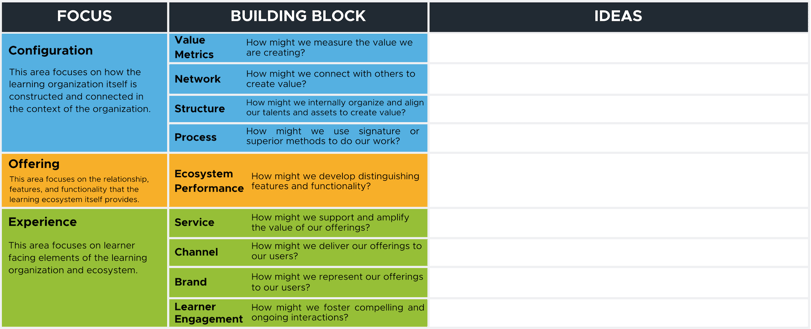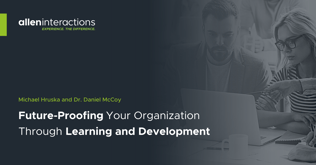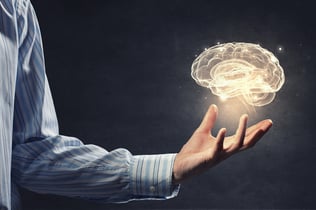Blog
Future-Proofing Your Organization Through Learning And Development
…because the technology has the capacity to create and destroy, we must compose for it a great purpose; our work of invention is only half of the ...


Future Proofing: Towards Giant Steps For Learning Innovation
By Michael Hruska and Daniel McCoy | April 02, 2020 | Custom Learning | 0 Comments
…because the technology has the capacity to create and destroy, we must compose for it a great purpose; our work of invention is only half of the future… - Timothy Freeman Cook
In a previous article, we talked about future-proofing your organization against inevitable irrelevance in a rapidly changing market. We argued for building an organization that is not only agile, but also adaptive. An “adaptive” organization can sense and anticipate change by leveraging people, data, communication, and collaboration. Any organization can do this if they recognize the power of learning and development and allow it to act as the central nervous system for the complex adaptive system; the organization, or “organism”. This endeavor presents a number of interesting challenges and requires new approaches, tools, and ways of thinking.
In this article, we look at the role of innovation for the adaptive learning organization. Innovation is generally thought of as a disruptive force for organizations and markets. Of course, not all disruptions are good for the health of people, companies, and economies. In order to discover innovation in our organizations using an “adaptive” lens perspective, we have to do a bit of futurecasting. In doing so, we might start by asking the following questions:
Where Is the Business Ultimately Trying to Go?
Strategic goals of L&D should be aligned to those of the business overall. But this is not always the case. Ask this question frequently. Knowing where the business is going helps L&D identify areas that, through innovation, need to evolve and meet business needs, drive results, add value, and remain relevant. It’s especially important to do this in highly matrixed organizations where the priorities of individual business units can drift out of alignment with each other and those of the organization.
What Is Our Current Ecosystem?
We can understand our current ecosystem by considering the complexity of interacting systems; people, processes, and technologies. We should be looking for the most flexible, efficient and impactful ways to enable these systems to interact. When we do this in our practice, we use a tool called the Learning Ecosystem Canvas. Capturing your learning ecosystem model is an important first step, but is not within the scope of this article.
To get the most out of this series, check out the first article, Future Proofing Your Organization Through Learning and Development.
What Signals Can We Use to Identify Our Evolutionary Path?
When we go looking for and find maximally adaptive potential, and vulnerabilities, we can use these as guideposts to point us to the possibilities for an organization’s evolution.
What Futurecasting Can We Innovatively Dream That Will Guide Our Chart?
If this sounds like astrology, it is in the sense that we are here attempting to predict the future. We should keep in mind that vision and strategy are only wishful thinking and won’t be executed well if we don’t recognize the factors on the ground that could limit them. It’s also critical that we don’t restrict our imagination to the present world. It should take only a few moments. Consider the recent innovations that were thought impossible or unlikely just a few years ago: self-driving cars, automated warehousing, gene editing, etc. Dreams can and do, become a reality.
How Might We Use Futurecasting to Develop Our Innovation Strategy?
Keeping in mind the principles of Agile and Lean, we need to guide innovation within our organization without constraining it. We can fail fast, fail often, iterate, and innovate simultaneously thinking of the likely future state of our organization within the ecosystem of the greater market. What will it look like to thrive in rapid change and ultimately drive it, not just survive it? Just as with all processes that support an adaptive organization, futurecasting should be frequent and iterative.
Learning Ecosystem Innovation Building Blocks
Larry Keely, author of Innovation Building Blocks has done significant work on understanding innovation. In his model, he outlines 3 major focus areas and ten building blocks for product/solution innovation. The key to his work is knowing that organizations who are innovating in 5 or more of the building blocks have a significant advantage in their market- whether it be stock price, market position, or valuation.
We have adapted this model to assist you in inventing or exploring ideas and creating design questions for how you might bring the innovation into your learning ecosystem design.
Use his exercise to outline the focus areas and building blocks to frame your innovation strategy. You can use a real or virtual white board, print as handouts, or print in a large format to capture input from a team

Let’s dig into some detail on the overall model. There are 3 major focus areas of the Learning Ecosystem Innovation Building Block model:
Configuration - This area focuses on how the learning organization itself is constructed and connected in the context of the organization.
Offering - This area focuses on the relationship, features, and functionality that the learning ecosystem itself provides.
Experience - This area focuses on learner facing elements of the learning organization and ecosystem.
Each of these elements has building blocks that can be used to explore and document ideas and design questions. The following section outlines the key building blocks for generating learning ecosystem innovation and a framing design question.
Configuration
Value Metrics - How might we measure the value we are creating?
Value Metrics focus on the ways that you might measure the value proposition defined in your Learning Ecosystem Canvas. While the Learning Ecosystem Canvas helps you get to the initial current state model within your organization, the purpose here is to really think outwardly and gather all of the conceivable means to measure value: not just now, but in the future.
Network - How might we connect with others to create value?
The Network refers to both internal and external connections that create value. This can include partnerships with SMEs, businesses, organization leaders, community leaders, data partnerships, and deeper relationships with process and business intelligence counterparts. The Network is the place where you can explore the edges of what can bring efficiency, effectiveness, and value to what you deliver.
Structure - How might we internally organize and align our talents and assets to create value?
The Structure building block defines how you internally organize talent and assets to create value and deliver the capabilities that the business needs now and in the future. This ranges from individual roles to the organizational structure of your team.
Process - How might we use signature or superior methods to do our work?
The Process building block helps with evaluating potential process inventions and ideas that could change the overall output and connectivity to the business. This building block is a frame for exploring the future methods which your learning organization might use to sense, create, and deliver output needed by the business.
Offering
Ecosystem Performance - How might we develop distinguishing features and functionality?
The Ecosystem Performance building block refers to the learning ecosystem itself. This block refers to the overall features and functionality that might be part of a learning ecosystem. This can extend beyond learning to concepts like knowledge management for example, and is a key building block for understanding the overall offering of the learning organization in the context of technology.
Experience
Service - How might we support and amplify the value of our offering?
This building block allows a frame to explore the more niche and personalized types of services that your organization might offer to the business for critical and strategic areas of competitive importance.
Channel - How might we deliver our offerings to our users?
The Channel building block allows exploration into achievable possible ways that you might deliver your future offerings. Maintaining the human connection in learning is important. This block should produce the widest variety of options for engaging with users. It should consider all learning modalities as viable options beyond digital to analog and face to face.
Brand - How might we represent our offerings to our users?
If there is any challenge or ambiguity in the current perception of your learning organization, you can use this block to explore a range of ideas that can incrementally or abruptly impact perceptions. Delivering value is one thing. Ensuring that your contribution is understood, viewed as important and valued by the organization is critical to overcoming any negative perceptions that may exist.
Learner Engagement - How might we foster compelling and ongoing interactions?
The Learner Engagement building block is focused on how to build, iteratively orient, and increase engagement of your users. Using this block is critical, as it is highly synergistic with and reinforces other blocks in this model. Engagement of learners from day zero to lifelong interactions is key to building their success, and that of the of the learning organization, while providing irrefutable value to the business.
Using the Canvas: Towards Giant Steps
The Canvas serves to give discrete “buckets” for you and any combination of your team to explore the boundaries of what is achievable. This can serve as the frame for your learning ecosystem innovation roadmap. Now that you are familiar with Learning Ecosystem Innovation Building Block model, we can explore a few different ways that you might get started in your organization.
- Personal exploration: You can use this model to capture your ideas and direct your inventive ideation toward potential futures. Ultimately, you’ll want to share these with your team, but this will give you a personal space to explore your thoughts and capture them.
- Team ideation: Collecting team input from the building block data can be done in a variety of formats.
- Team exploration: Introduce the purpose of the building block framework. Following this, provide a few concrete examples to get people oriented to each block. Follow this with timed sprints of 15 to 20 minutes to ideate, capture, explain, and add items to the model. You can run as many iterations as you like, as long as the team is adding ideas and digging deeper into how any given idea would be implemented.
- Silent writing: This can be used as part of the team brainstorm model. It entails a first sprint of 5 to 10 minutes of time for individuals silently to develop their own ideas. At the end, each person would add their ideas to the appropriate building block, share them, and provide some additional information. This method allows for unbiased idea generation and should start to show you who your most inventive thinkers are. You can continue with the team brainstorm model above or keep working on individual sprints as you see fit.
- Competitive exploration: If you have a large group, introduce the model and then break people out into 3 or 4 person teams. In some cases, it may be appropriate to say that they now “work for a competitor” or a “brand new company” to further remove constraint-based thinking. Letting them name their team freely is always a nice touch. These teams, for any number of sprints, are told to build their own innovation models. After completing the models, each team presents their model to the others.
These methods are a good starting point for exploring future possibilities across the model. There are a few other things you’ll want to consider when using this framework:
Mutual Exclusivity
Many times, people have discrete ideas that can’t be categorized easily. Make it clear to your participants that their ideas may fit in or cover more than one building block. The blocks are to help stimulate ideas. Aim to have participants work more on coming up with ideas and less on where they may fit in a block.
Questions Are as Good as Ideas
“How might we” (HMW) questions are framed for each building block. These HMW questions highlight the possibility for each of the blocks with a focus on “might” vs. “will” or “should”. The questions meant to encourage ideas in each building block. It’s perfectly fine to further develop HMW questions in any given building block.
Example: In the customer engagement or brand building blocks, you might frame a question along the lines of “HMW introduce our learning organization, ecosystem, and services during onboarding to make users feel that we are a guide, friend, and mentor for their entire career journey in our organization?”
This Is a Journey
Your initial capture here is not the end of anything! It is the beginning of the next chapter of moving toward the giant steps your learning organization will have to take in the future to support your organization’s needs in the emerging landscape. So, once you get your initial capture, you can continue to seek, explore, and validate ideas.
Build a Roadmap
This gives you the ability to gather and evaluate the ideas with impact. You can have teams vote on what is most important or impactful, or work with stakeholders to identify the top ideas with the most potential impact. This prioritization of ideas can be turned into an innovation roadmap showing in which month or quarter the building blocks, ideas, or deeper design questions are in focus.
Innovating Towards Adaptability
Defining innovation itself is often hard. Bill Aulet (author of Disciplined Entrepreneurship) defines innovation the following way:
Innovation = invention X commercialization. Commercialization, or bringing the solution to fruition, is important in addition to the invention. So if the invention is the discovery of items that might bring innovation if commercialized, then how do we explore the possibilities for invention?
In this article, we have promoted the idea that innovation, done the right way, will lead to a future state where we have a competitive advantage and where our organization is creating the disruptions in the market rather than responding to them. We have positioned L&D at the forefront of the process given the right tools and ways of thinking. In this light, innovation should be considered a thread for design thinking to be woven into our organization’s transformation—not an afterthought.
So far, we have explored transformation potential using two different models. In the next segment, we’ll start to explore some starting points to seek and drive organizational impact through designing learning differently… These next models are best built on the learning ecosystem canvas and learning ecosystem innovation building block models!
These and the following tools, assist in defining ways to help your organization (which itself is a complex adaptive system) in new ways and through people, deliver fresh capabilities.
Download your Future-Proofing Resource toolkit now to access complimentary resources like:
- Learning Ecosystem Canvas
- Learning Ecosystem Innovation Building Blocks
- Adaptive Learning Organization Scorecard
- Webinar: Elements of the Learning Ecosystem Canvas
- White Paper: How Adaptive Learning Organizations Improvise and Innovate in the Face of Rapid Change
About the Author: Michael Hruska and Daniel McCoy
Comments
Would you like to leave a comment?
Related Blog Posts

By: Michael Hruska and Daniel McCoy | Apr, 2020
Category: Custom Learning, Strategic Consulting
.png?width=316&name=2023%20Blog%20Covers%20and%20In-Line%20Graphics%20(9).png)
Blog
3 Steps to Becoming an Adaptive Learning Organization
…because the technology has the capacity to create and destroy, we must compose for it a great purpose; our work of invention is only half of the ...
By: Michael Hruska and Daniel McCoy | Feb, 2023
Category: Custom Learning, Strategic Consulting

Blog
Enabling an Empowered Distributed Workforce
…because the technology has the capacity to create and destroy, we must compose for it a great purpose; our work of invention is only half of the ...
By: Michael Hruska and Daniel McCoy | Apr, 2020
Category: Custom Learning

